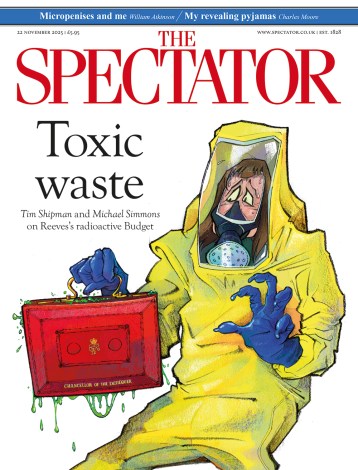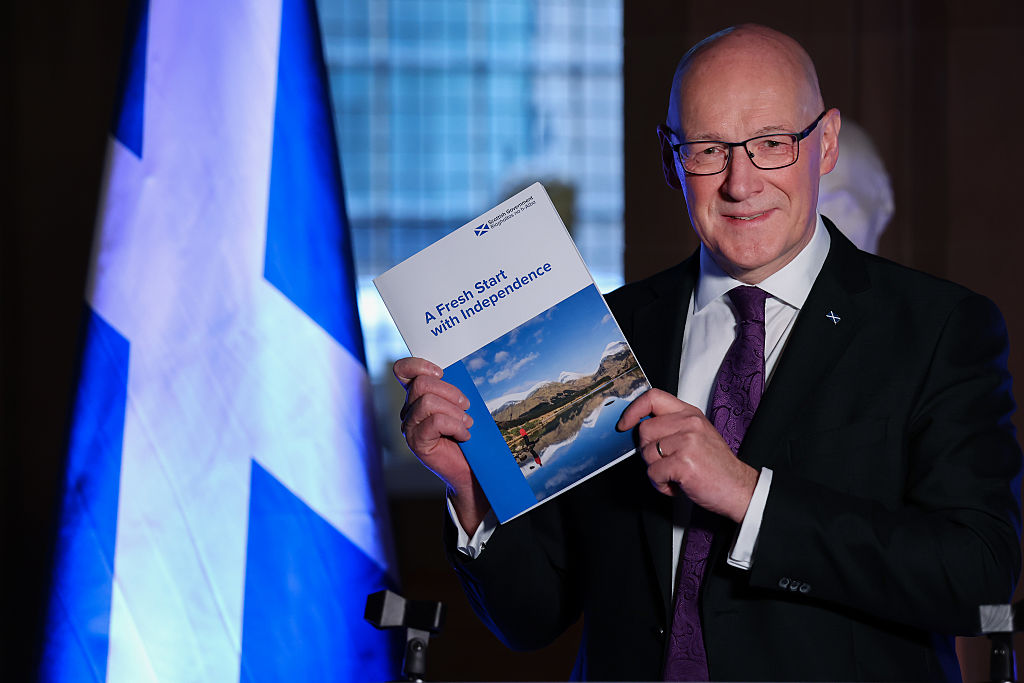The SNP government in Edinburgh has published another white paper on the constitution, ‘A Fresh Start with Independence’. It’s a bold title when your last white paper on this issue was published a whole 34 days ago. Indeed, between June 2022 and April 2024, the Scottish Government produced 13 white papers on independence. Putting out yet another and branding it ‘a fresh start’ is a bit like Taylor Swift releasing an album of diss tracks about her exes and calling it A New Direction. (Not that I’m comparing John Swinney to Taylor Swift. Taylor Swift has actually contributed to the Scottish economy.)
‘A Fresh Start’ is decidedly stale in substance, replete with the same magical thinking and evasive language that have been the hallmark of the SNP’s independence white papers since Scotland’s Future in 2013. It’s not like there isn’t a case for Scottish independence, just that there isn’t the kind of case the SNP wants to make, namely that Scotland can leave the United Kingdom on its own terms, retaining all the advantages of the British state (intra-UK free movement of goods and labour, the state pension, the pound) while ditching things the public dislikes (Tory governments, child poverty, the cost-of-living crisis). After 18 years at the helm of the Scottish government, with an army of civil servants at their disposal, the SNP is still promising every voter a unicorn that egests gold. It’s risible, yes, but it’s also insulting.
An example: the latest white paper claims that ‘a new model for the Scottish economy could see your living standards begin to rise to match those of other, comparable independent nations in Europe’. Now, set aside the prose, which sounds like those daytime TV ads that sell life insurance to the over-50s, and appropriately so since both can drain your savings and give you back less than you put in. No, pay attention to the suggestion that living standards ‘could… begin to rise’. No government, those of ‘comparable independent nations in Europe’ or otherwise, can guarantee an increase in living standards because while the state plays a role via public services, welfare, and redistribution, the market plays an even bigger role — even in social democratic Scandinavia, which the SNP likes to talk about but has no credible plan to imitate.
Ah, but it does say ‘could’. That it does. What it doesn’t say is that living standards could just as easily drop if an independent Scotland failed to generate prosperity, increase skills, invest in infrastructure, and better manage health inequalities. ‘Could’ does not absolve them when their rhetoric is geared towards households which are struggling financially and those in even sharper desperation. The nationalists did the same thing during the 2014 referendum. They went into all the big council estates in Easterhouse, Castlemilk, Ferguslie Park and Torry, home to some of the most poverty-stricken families in Scotland, and peddled a cruel fantasy of untold wealth and utopian equality just waiting on the other side of the ballot box. In many cases it worked, and if these voters were disappointed in the final result, at least it spared them the economic punch in the gut that independence would likely have delivered at that time.
Of course, this white paper is not a sincere piece of argumentation for Scotland exiting the UK. It is about pandering to the SNP’s impatient grassroots ahead of the party’s conference in Aberdeen this weekend. The Scottish government can’t deliver for Scotland; the best it can do is deliver for the SNP leader’s internal party management needs. Westminster has nothing to fear from this white paper or any of the others, just as it has nothing to fear from Swinney and what remains of the SNP machine. Swinney has neither the capacity nor, it seems, the drive to secure another independence referendum. That’s why he’s handing out white papers and not ballot papers.
There are three routes to independence. First, convince Westminster to keep giving you referendums until you win. Frustrated Scottish nationalists have soured on this approach, convinced Westminster would never risk another vote, but this is to underestimate a) Westminster’s capacity for constitutional self-harm and b) the prevalence in Whitehall of PPE wide-boys and fridge-temperature-IQ lanyard drongos who think the North begins at Luton but know all about Scotland because they once got proper wrecked at a mate’s wedding in St Andrews. Remember Daisley’s Law of Inadvertent Masochism: the more harm a policy does to Britain’s interests, the more convinced Westminster becomes that Britain must adopt it. This remains the SNP’s best chance of achieving Scexit.
Second, run the Scottish government effectively, prioritise economic growth and public service reform, make modest promises and fulfil them, earn a reputation for competence. Do the hard work on the outstanding questions about secession and come up with credible, if not universally loveable, answers on currency, deficits, borders, pensions, defence, and Europe. Be optimistic about demographic trends but take nothing for granted, then, in time, reintroduce independence as the continuity option to secure and build on a record of improvement. This is what should have happened after the SNP lost the 2014 referendum. What happened instead was Nicola Sturgeon.
Third, the Catalan option. Defy the UK Government and the Supreme Court and hold a wildcat plebiscite, a referendum not only on independence but the principle that the Scots should decide their own future. Leverage Westminster’s disregard of the vote, or, even better, Barcelona-style scenes of police seizing ballot boxes, to bring even Unionist voters into the independence camp. Follow up with mass marches in London and non-violent civil disobedience until Downing Street figures the Union is more hassle than it’s worth. The late Alex Salmond might have pulled this off but there is no one in Scottish politics today with the popular support or political nerve to try this.
Beyond these three strategies, nothing else matters. Not white papers, not speeches, not votes in Holyrood, not the 879th National front page unveiling the latest super-duper, same-but-different, sure-to-work-this-time independence plan. Until the SNP gets serious about the constitution, and gets a leader capable of moving the secession agenda forward, it’s all just ink on paper. Scotland might need a fresh start, but not half as much as the SNP.








Comments